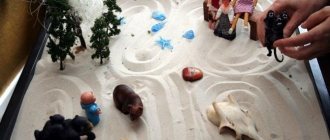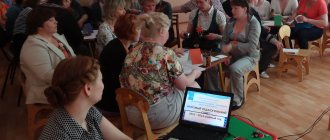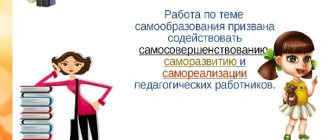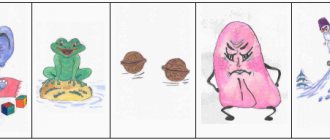Presentation: “Modern educational technologies in preschool educational institutions” presentation on the topic
Slide 1
Modern educational technologies in preschool educational institutions Safarova Yu.V. Yalutorovsk 2016
Slide 2
Technology is a set of techniques used in any business, skill, or art (explanatory dictionary). Pedagogical technology is a set of psychological and pedagogical attitudes that determine a special set and arrangement of forms, methods, methods, teaching techniques, educational means; it is an organizational and methodological toolkit for the pedagogical process. (B.T. Likhachev) A child is brought up by various accidents that surround him. Pedagogy must give direction to these contingencies. V. F. Odoevsky
Slide 3
Educational Technology Structure
Slide 4
Modern educational technologies, health-saving technologies; technology of developmental training in technology of project activities; information and communication technologies; person-oriented technologies; portfolio technology for preschoolers and teachers; gaming technology; TRIZ technology, etc.
Slide 5
Health-saving technologies The goal of health-saving technologies is to provide the child with the opportunity to maintain health, to develop in him the necessary knowledge, skills and habits for a healthy lifestyle. Health-saving pedagogical technologies include all aspects of the teacher’s influence on the child’s health at different levels - informational, psychological, bioenergetic.
Slide 6
In modern conditions, human development is impossible without building a system for the formation of his health. The choice of health-saving pedagogical technologies depends on: the type of preschool institution, the length of stay of children in it, the program under which teachers work, the specific conditions of the preschool educational institution, the professional competence of the teacher, and children’s health indicators.
Slide 7
Technologies for preserving and stimulating health types of use Finger gymnastics From a young age, with a subgroup and the whole group daily. Dynamic pauses During NOD, 3-5 min. As children from the 2nd junior group get tired, Gymnastics for the eyes Daily for 3-5 minutes. Depending on the intensity of the load, it can be included in physical education minutes during non-breathing exercises Breathing exercises In various forms of physical education and health work, starting from a young age
Slide 8
Invigorating gymnastics After sleep in a group, daily self-massage using dry rubbing After sleep as part of health-improving activities from middle age Hardening activities, health paths After sleep, daily, starting from a young age. During ECD in physical education Outdoor and sports games (elements of sports games) As part of ECD in physical education, on a walk, in a group (of moderate and low mobility), daily, all age groups.
Slide 9
GCD for physical education Three times a week, all age groups In the gym, in a group, on a walk in accordance with the program Morning exercises Every day, in music and sports halls, in a group. All age groups Classes from the “Health” series (Shorygina T.A. Conversations about health. Avdeeva N.N., Knyazeva O.L., Sterkina R.B. Safety.) Once a week in routine processes, as part or a whole GCD for knowledge Physical education and holidays Once a quarter. Starting from a young age in the gym, on a walk Technologies for teaching a healthy lifestyle
Slide 10
Corrective technologies of exercise therapy For medical reasons in a compensatory group, conducted by a specialist Massage For medical indications in a compensatory group, performed by a specialist Articulatory gymnastics In compensatory groups in regime processes and as part of ECD for communication psycho-gymnastics In individual, group, subgroup classes with a psychologist and teachers fairytale therapy In individual, group, subgroup classes with a psychologist and educators Relaxation Technologies of musical influence In individual, group, subgroup classes with a psychologist and educators
Slide 11
Technology of developmental education Developmental education is a direction in the theory and practice of education, focusing on the development of the physical, cognitive and moral abilities of students through the use of their potential. This is motivation for specific actions, for knowledge, for new things. These include the developmental environment of the preschool educational institution, the preschool educational institution program.
Slide 12
Technologies of research activities The goal of research activities in kindergarten is to form in preschoolers the basic key competencies and the ability for a research type of thinking. For research activities, types of research that are accessible and interesting to children of senior preschool age can be selected
Slide 13
Methods and techniques for organizing experimental research activities: heuristic conversations; raising and solving problematic issues; observations; modeling (creating models about changes in inanimate nature); experiments; recording the results: observations, experiences, experiments, work activities; imitation of voices and sounds of nature; use of artistic words; didactic games, game-based educational and creative development situations;
Slide 14
Technology of project activity Goal: Development and enrichment of social and personal experience through the inclusion of children in the sphere of interpersonal interaction. Teachers who actively use project technology in the upbringing and teaching of preschoolers unanimously note that life activities organized according to it in kindergarten allow them to get to know the students better and penetrate into the child’s inner world.
Slide 15
Project activities include: A task for children, formulated in the form of a problem; Purposeful children's activities; Forms of interaction between children with the teacher, with each other, and parents; The result of the activity as a way for the children to solve the project problem.
Slide 16
Project activities of preschoolers can be Cognitive and research in nature Playful in nature Creative in nature Duration: Short-term projects (1 week - six months) Long-term (six months - several years)
Slide 17
The TRIZ technology (the theory of solving inventive problems) was created by the scientist-inventor T.S. Altshuller. The teacher uses non-traditional forms of work that put the child in the position of a thinking person. TRIZ technology adapted for preschool age allows you to educate and train a child under the motto “Creativity in everything!”
Slide 18
The purpose of using this technology in kindergarten is: development, on the one hand, of such qualities of thinking as flexibility, mobility, systematicity, dialecticity; on the other hand, search activity, the desire for novelty; speech and creative imagination.
Slide 19
Information and communication technologies The world in which a modern child develops is fundamentally different from the world in which his parents grew up. This places qualitatively new demands on preschool education as the first link of lifelong education: education using modern information technologies (computer, interactive whiteboard, tablet, etc.).
Slide 20
Advantages of a computer Presenting information on a computer screen in a playful way arouses great interest among children; carries a figurative type of information that is understandable to preschoolers; movements, sound, animation attract the child’s attention for a long time; has a stimulus for children's cognitive activity; provides the opportunity to individualize training; in the process of working at the computer, the preschooler gains self-confidence; allows you to simulate life situations that cannot be seen in everyday life.
Slide 21
ICT in the work of a modern teacher 1. Selection of illustrative material for classes and for the design of stands, groups, classrooms (scanning, Internet, printer, presentation). 2. Selection of additional educational material for classes, familiarization with scenarios for holidays and other events. 3. Exchange of experience, acquaintance with periodicals, the developments of other teachers in Russia and abroad. 4. Preparation of group documentation and reports. The computer will allow you not to write reports and analyzes every time, but rather just type the diagram once and then only make the necessary changes. 5. Creating presentations in the Power Point program to improve the effectiveness of educational classes with children and the pedagogical competence of parents in the process of holding parent-teacher meetings. Using a multimedia projector in classes, at teacher councils, and RMOs
Slide 22
Personality-oriented technology Personality-oriented technologies place the child’s personality at the center of the entire preschool education system, ensuring comfortable conditions in the family and preschool institution, conflict-free and safe conditions for its development, and the realization of existing natural potentials. Personality-oriented technology is implemented in a developmental environment that meets the requirements of the content of new educational programs.
Slide 23
Directions of person-oriented technologies Humane-personal technologies, distinguished by their humanistic essence and psychological and therapeutic focus on providing assistance to a child with poor health, during the period of adaptation to the conditions of a preschool institution. The technology of cooperation implements the principle of democratization of preschool education, equality in the relationship between teacher and child, partnership in the system of relationships “Adult - child”.
Slide 24
Pedagogical technologies based on humanization and democratization of pedagogical relations with procedural orientation, priority of personal relationships, individual approach, democratic management and a strong humanistic orientation of the content. The new educational programs “Childhood”, “From Birth to School”, “Rainbow”, “From Childhood to Adolescence” have this approach. The essence of the technological educational process is constructed on the basis of given initial settings: social order (parents, society), educational guidelines, goals and content of education. These initial guidelines should specify modern approaches to assessing the achievements of preschoolers, as well as create conditions for individual and differentiated tasks.
Slide 25
Personality-oriented technologies contrast the authoritarian, impersonal and soulless approach to the child in traditional technology - an atmosphere of love, care, cooperation, and create conditions for individual creativity.
Slide 26
Portfolio technology for a preschooler A portfolio is a collection of a child’s personal achievements in various activities, his successes, positive emotions, an opportunity to once again relive the pleasant moments of his life, this is a unique route for the child’s development. There are a number of functions of a portfolio: diagnostic (records changes and growth over a certain period of time), content-based (reveals the entire range of work performed), rating (shows the range of skills of the child), etc. The process of creating a portfolio is a kind of pedagogical technology.
Slide 27
There are a lot of portfolio options. The content of the sections is filled out gradually, in accordance with the capabilities and achievements of the preschooler. The portfolio has its own structure and consists of sections. A number of authors offer their own structure and content of a preschool child’s portfolio. A portfolio (a folder of a child’s personal achievements) allows for an individual approach to each child and is presented upon graduation from kindergarten as a gift to the child and his family.
Slide 28
Technology “Teacher's Portfolio” Modern education needs a new type of teacher: a creative thinker who is proficient in modern educational technologies, methods of psychological and pedagogical diagnostics, methods of independently constructing the pedagogical process in the conditions of specific practical activities, and the ability to predict their final result.
Slide 29
Every teacher should have a record of success, which reflects everything joyful, interesting and worthy that happens in the life of a teacher. A teacher’s portfolio can become such a dossier. A portfolio allows you to take into account the results achieved by a teacher in various types of activities (educational, educational, creative, social, communicative), and is a form of assessing the professionalism and effectiveness of a teacher’s work.
Slide 30
Gaming technology Gaming technologies are closely related to all aspects of the educational work of a kindergarten and the solution of its main tasks. Pedagogical technology for organizing director's games for children Pedagogical technology for organizing role-playing games
Slide 31
It is built as a holistic education, covering a certain part of the educational process and united by common content, plot, and character. It includes sequentially: games and exercises that develop the ability to identify the main, characteristic features of objects, compare and contrast them; groups of games to generalize objects according to certain characteristics; groups of games, during which preschoolers develop the ability to distinguish real from unreal phenomena; groups of games that develop the ability to control oneself, speed of reaction to a word, phonemic hearing, ingenuity, etc. Compiling gaming technologies from individual games and elements is the concern of every educator.
Slide 32
Technology of integrated learning (Sazhina S.D. “Technology of integrated classes in preschool educational institutions”) Integration combines knowledge from different educational fields on an equal basis, complementing each other. At the same time, several development problems are solved. In the form of an integrated GCD, it is better to summarize the material and conduct final activities.
Slide 33
Non-traditional drawing techniques A.V. Nikitina “Non-traditional drawing techniques in kindergarten” G.N. Davydova “Non-traditional drawing techniques in kindergarten” T.A. Tskvitaria “Non-traditional drawing techniques. Integrated classes in preschool educational institutions” K.K. Utrobina "Fascinating drawing using the poking method with children 3-7 years old"
Slide 34
The technological approach, that is, new pedagogical technologies guarantee the achievements of preschoolers and subsequently guarantee their successful learning at school. Every teacher is a creator of technology, even if he deals with borrowings. The creation of technology is impossible without creativity. For a teacher who has learned to work at the technological level, the main guideline will always be the cognitive process in its developing state. Everything is in our hands, so they can not be omitted.
Slide 35
A person cannot truly improve unless he helps others improve. Charles Dickens Create your own. Just as there are no children without imagination, there is no teacher without creative impulses. I wish you creative success!



